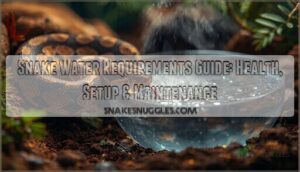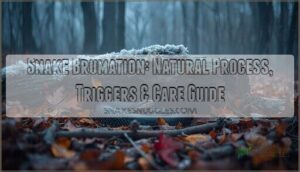This site is supported by our readers. We may earn a commission, at no cost to you, if you purchase through links.
 Feeding mice to snakes isn’t for everyone. The sight of a frozen rodent thawing on the counter or the thought of live prey can turn squeamish owners away from snake keeping entirely. Yet about 8% of commonly kept pet snakes never need to touch a mouse.
Feeding mice to snakes isn’t for everyone. The sight of a frozen rodent thawing on the counter or the thought of live prey can turn squeamish owners away from snake keeping entirely. Yet about 8% of commonly kept pet snakes never need to touch a mouse.
These species have evolved specialized diets that range from insects and bird eggs to fish and earthworms. Rough green snakes snap up crickets and spiders, while African egg-eating snakes consume nothing but whole eggs throughout their lives. Garter snakes and water snakes thrive on fish-based diets with proper supplementation.
Understanding these alternatives opens snake ownership to people who appreciate reptiles but can’t stomach rodent feeding.
Table Of Contents
- Key Takeaways
- Is There a Pet Snake That Can’t Eat Mice?
- Types of Pet Snakes With Non-Mouse Diets
- Diet and Nutrition for Non-Mouse-Eating Snakes
- Care Requirements for Non-Rodent Snakes
- Choosing The Right Non-Mouse-Eating Snake
- Frequently Asked Questions (FAQs)
- Do snakes eat mice?
- Do snakes eat rodents?
- Why is it hard to feed mice to snakes?
- Do blind snakes eat mice?
- Do green snakes eat mice?
- Do sea snakes eat rodents?
- Can you have a pet snake and not feed it mice?
- Are there any snakes that don’t eat meat?
- What can I feed my snake if I don’t have mice?
- Do vegetarian snakes exist?
- Conclusion
Key Takeaways
- About 8% of commonly kept pet snakes thrive on specialized diets that don’t include mice, with options ranging from insect-eaters (rough and smooth green snakes) to egg-eaters (African egg-eating snakes) and fish-eaters (garter and water snakes).
- Non-rodent snake diets require careful supplementation to prevent nutritional deficiencies—insect-eaters need calcium and vitamin D3 dusting, while fish-eaters face thiaminase risks that can deplete essential vitamins like thiamine.
- Garter snakes are the most beginner-friendly non-rodent option because they tolerate handling well and accept varied diets including fish and earthworms, whereas egg-eaters and insect-eaters demand more specialized care and consistent food sourcing.
- All snakes are obligate carnivores with no vegetarian species existing—their digestive systems evolved exclusely for processing animal prey, though the prey type varies widely from insects and eggs to fish and amphibians depending on the species.
Is There a Pet Snake That Can’t Eat Mice?
Yes, several pet snake species can thrive without ever eating mice. About 8% of commonly kept snakes fall into this category, offering real dietary alternatives for owners uncomfortable with feeding rodents.
These nonmouse-eating pet snakes include insectivores like rough green and smooth green snakes, which eat crickets and spiders exclusively. African egg-eating snakes consume only bird eggs throughout their lives. Garter snakes and water snakes can survive on fish, earthworms, and amphibians with proper supplementation.
This species variety means you don’t have to compromise on snake welfare or your ethical concerns. Some of these options work well as beginner options, though they require different care approaches than traditional pet snakes. Many insect-eating snakes display somber coloration for effective camouflage.
Understanding alternative snake diets helps you make informed choices that align with both your values and your snake’s nutritional needs.
Types of Pet Snakes With Non-Mouse Diets
You have several options when it comes to pet snakes that skip the rodent menu. These species naturally eat insects, eggs, or aquatic prey in the wild, and you can replicate those diets in captivity.
Let’s look at the main categories you’ll encounter.
Insect-Eating Snakes (Rough Green, Smooth Green)
Rough Green Snakes and Smooth Green Snakes thrive on insectivorous diets instead of alternative snake diets based on rodents. You’ll need to offer insect prey variety like crickets, caterpillars, spiders, and grasshoppers—roughly 85% of their nutrition comes from arthropods. Supplementation needs include calcium and vitamin D3 dusting at least twice weekly to prevent deficiencies.
Proper snake habitat includes live or artificial plants for climbing. Habitat enrichment with climbing branches bolsters their arboreal nature, though population threats from pesticides make captive breeding increasingly important for ethical ownership.
Egg-Eating Snakes (African, Indian)
Egg-eating snakes offer a fascinating non-rodent diet alternative, though they require specialized anatomy knowledge for proper captive care. African Egg-Eating Snakes (Dasypeltis species) and the rarer Indian Egg-Eater consume only bird eggs—no mice whatsoever. Their toothless jaws and modified vertebrae crack eggshells internally, separating liquid from shell fragments.
Egg-eating snakes survive entirely on bird eggs, using toothless jaws and specialized vertebrae to crack shells internally without ever consuming mice
You’ll need consistent access to appropriately sized quail, finch, or small chicken eggs. Conservation status varies, with African species readily available while Indian egg-eaters face habitat threats and limited availability in the pet trade.
Fish- and Amphibian-Eating Snakes (Garter, Water Snakes)
Garter snakes and water snakes thrive on fish-based diets, though you’ll need to manage thiaminase risks from goldfish and minnows by offering safer alternatives like silversides or trout.
Amphibian parasites make feeding frogs problematic, so frozen/thawed rodents often supplement their snake diet for dietary enrichment.
Feeding frequency varies—juveniles eat every other day, while adults consuming mice need weekly meals.
Their habitat features must include shallow water dishes for soaking, supporting their semi-aquatic nature.
Diet and Nutrition for Non-Mouse-Eating Snakes
Getting the nutrition right for snakes that skip mice takes some planning. You’ll need to think about which vitamins and minerals might be missing from their alternative diets, where to find quality food sources, and how often to feed them.
Let’s break down what you need to know to keep your non-rodent-eating snake healthy.
Essential Nutrients and Supplementation
Your snake’s body can’t run on good intentions alone—it needs specific protein sources, fats, vitamins, and minerals to thrive. Fish-eating species often face vitamin deficiencies, particularly thiamine depletion from enzymes in prey fish. Mineral imbalances and inadequate fat requirements also threaten snake health over time.
Supplementation risks exist when you over-dust prey with calcium or vitamin D3 powders, potentially causing toxicity. Understanding reptile nutrition and nutritional balance helps you prevent these problems and maintain peak snake health through targeted snake supplementation strategies.
Sourcing and Preparing Alternative Foods
Finding quality food means choosing ethical sourcing and understanding alternative prey options for feeding pet snakes. Commercial suppliers like RodentPro offer frozen chicks, quail, and fish—nonmice diets designed to meet species-specific needs. Proper prey preparation and food storage keep these alternative diets for snakes safe and nutritious.
- Gut-load insects with nutritious foods and dust with calcium powder before offering
- Freeze and thaw poultry or fish properly to eliminate parasites and disease risk
- Store frozen prey separately from human food in sealed containers below 0°F
- Source appropriately sized eggs (button quail for juveniles) from specialty suppliers for egg-eating species
Feeding Frequency and Portion Control
Generally, adults eat once every one to two weeks, while juveniles need meals twice weekly. However, snake feeding requirements vary considerably by diet type. Insect-eating species need feeding every 2–3 days due to their high metabolism and small prey size. Egg-eating snakes consume 1–2 eggs weekly, depending on their nutritional needs.
| Diet Type | Juvenile Frequency | Adult Frequency | Prey Size Guidelines | Key Nutritional Needs |
|---|---|---|---|---|
| Insects | Every 2–3 days | Every 2–3 days | Soft-bodied larvae preferred | Calcium supplementation required |
| Eggs | 1–2 per week | 1–2 per week | No larger than 3× head size | Dietary variety (quail, finch) |
| Fish/Amphibians | Every other day | Twice weekly | 10–15% of body weight | Minimize thiaminase-rich fish |
Overfeeding risks include regurgitation and digestive stress when prey exceeds mid-body diameter. Alternative feeding methods should emphasize dietary variety to prevent nutritional deficiencies while matching feeding schedules to each species’ metabolism.
Care Requirements for Non-Rodent Snakes
Keeping non-rodent snakes healthy goes beyond offering the right diet. You’ll need to fine-tune their habitat, watch for signs of nutritional gaps, and understand how each species likes to be handled.
Here’s what matters most for their long-term care.
Habitat Setup and Environmental Needs
Your enclosure setup directly impacts whether your non-rodent snake species thrive or merely survive. Reptile care for these pet snakes demands attention to several interconnected habitat parameters that work together to support natural behaviors and physiological processes.
Key environmental factors for proper enclosure design include:
- Temperature gradients: Maintain a 10–15°F difference between basking (88–90°F) and cool zones (72–80°F) using heat mats or ceramic emitters covering one-third of the habitat
- Humidity control: Monitor levels with digital hygrometers, targeting 50–75% for rough green snakes through daily misting and humid hides lined with moist sphagnum moss
- Enrichment items: Provide climbing branches, grapevine, hollow cholla wood, and dry leaves to encourage natural movement patterns in arboreal and terrestrial snake species
Lighting needs include 8–13 hours daily with all lamps off at night. Enclosure security requires locking screen covers—these snakes easily escape through small gaps.
Monitoring Health and Preventing Deficiencies
You can’t rely on guesswork when alternative feeding methods replace conventional prey. Regular veterinary checkups—ideally twice yearly—catch early signs of nutritional imbalance through fecal analysis and blood work.
Weight monitoring every month reveals whether your snake’s nutritional balance is on track; healthy individuals stay within 10% of baseline mass.
Vitamin supplementation and careful attention to hydration importance prevent deficiencies that compromise snake health and wellbeing, especially in species eating only insects or fish.
Handling and Temperament Considerations
Non-rodent pet snakes often show calmer temperaments than their rodent-eating cousins, making safe handling easier for beginners. Regular handling frequency—about twice weekly—reduces defensive strikes by 45% compared to rarely handled snakes.
Watch for these temperament indicators:
- Relaxed breathing and gentle tongue-flicking signal low stress levels in 75% of observed individuals
- Tight coiling or head-hiding behaviors reveal fear-based responses requiring immediate stress reduction
- Cloacal discharge during contact indicates acute distress in roughly 40% of frightened snakes
Allow a 7–14 day acclimation period before handling newly acquired snake species for beginners.
Choosing The Right Non-Mouse-Eating Snake
Not all non-mouse-eating snakes are created equal in terms of ease of care. Some species adapt well to captivity and accept alternative diets without fuss, while others demand specialized conditions that can challenge even experienced keepers.
Let’s look at which species work best for different experience levels, where you can find them, and what to think about before bringing one home.
Beginner-Friendly Species
If you’re new to snake care and feeding, garter snakes stand out as the most beginner-friendly pet snakes with non-rodent diets. They tolerate handling better than insect-eating species and adapt to varied diets that include fish, earthworms, and amphibians. Temperament concerns are minimal compared to egg-eaters, which require specialized feeding. African egg-eating snakes offer gentle handling ease but demand consistent access to appropriately sized eggs—a challenge for first-time keepers.
Snake species for beginners should balance manageable snake care and feeding routines with realistic dietary needs and enclosure size requirements.
| Species | Why Beginner-Friendly |
|---|---|
| Garter Snake | Tolerates handling; accepts diverse dietary needs including fish and earthworms |
| African Egg-Eating Snake | Calm temperament; manageable enclosure size (36x18x12 inches) |
| Smooth Green Snake | Small size reduces initial costs; straightforward insect diet |
| Rough Green Snake | Low aggression but stress-sensitive; requires minimal contact |
Sourcing and Availability in The Pet Trade
You’ll find garter snakes at roughly 15% of North American reptile retailers, while rough green snakes and egg-eaters remain harder to source. Online platforms now handle 60% of pet snake sales, expanding access to captive-bred, non-mouse-eating species.
Regional variations affect availability—European breeders increased captive-bred stock 11% since 2022, addressing ethical concerns around wild capture that still impacts rough green snake populations.
Ethical and Practical Considerations
Before committing to nonrodent snake diets, weigh three critical factors:
- Welfare impacts: Live feeding causes distress to prey and injury risk to snakes—pre-killed alternatives reduce harm while meeting nutritional needs.
- Sourcing ethics: Wild-caught rough green snakes suffer higher mortality; choose captive-bred specimens to avoid conservation issues.
- Dietary challenges: Fish-based diets risk thiaminase toxicity, while insect-only feeding may shorten lifespan without proper supplementation and variety.
Ethical pet snake ownership means matching species’ complex biological needs with your capacity to provide specialized care consistently.
Frequently Asked Questions (FAQs)
Do snakes eat mice?
Most pet snakes, over 90%, consume mice as their primary food source. Mice deliver balanced proteins, fats, and essential vitamins that support snake health.
However, alternative prey options exist for those with ethical feeding concerns or preferences for nonmouseeating pet snakes.
Do snakes eat rodents?
Most wild snakes do consume rodents as part of their natural diet, but snake dietary adaptations vary widely by species. While rodent consumption frequency is high among many colubrids and vipers, alternative prey options like insects, fish, amphibians, and eggs sustain other species without any rodent diet necessity.
Why is it hard to feed mice to snakes?
Feeding mice isn’t always difficult, but several challenges can arise. These include prey refusal due to stress or learned aversion, jaw anatomy limiting gape size for larger rodents, and ethical concerns about live feeding.
Additionally, nutritional deficiencies can occur from single-prey diets, and there are zoonotic risks from pathogens like Salmonella.
Do blind snakes eat mice?
Blind snakes have a specialized diet, consisting only of ants, termites, and their soft larvae. They never consume mice or other vertebrates.
These snakes are tiny, measuring just four to six inches long. Their jaw mechanics are uniquely adapted for feeding on invertebrates, not rodents.
Do green snakes eat mice?
No, green snakes don’t eat mice. Rough Green Snakes and Smooth Green Snakes are insect-eating snakes with natural diets of crickets, spiders, and caterpillars. Their small mouths and prey size limitations make rodents impossible to consume in captive care.
Do sea snakes eat rodents?
Sea snakes feed exclusively on aquatic prey like fish, eels, and fish eggs in their marine habitats. Rodents don’t inhabit open ocean environments, making dietary overlap biologically impossible. These snakes’ venom and digestive adaptations are specialized for marine food webs, not terrestrial prey.
Can you have a pet snake and not feed it mice?
Yes, you can keep a pet snake without feeding mice. Several species thrive on dietary alternatives like insects, fish, eggs, or amphibians.
These non-mouse-eating pet snakes offer ethical concerns relief while maintaining snake health through proper snake nutrition and alternative feeding methods for snakes adapted to snake size.
Are there any snakes that don’t eat meat?
All snakes are carnivores—none consume plant matter, fruits, or algae as herbivores or frugivores would. While insectivores and those eating alternative prey options like eggs or fish aren’t rodent-eaters, vegetarian snakes simply don’t exist in nature.
What can I feed my snake if I don’t have mice?
If you don’t have mice, you can offer alternative prey items like fish, insects, amphibians, or eggs, depending on your snake’s species.
Nutritional supplementation and dietary variety are essential for nonmouse-eating pet snakes to prevent deficiencies and maintain health.
Do vegetarian snakes exist?
No truly plant-eating snakes exist in nature. All snakes are obligate carnivores with digestive systems and evolutionary adaptations built exclusively for processing animal prey.
Their nutritional needs simply can’t be met through plant matter, making vegetarian diets impossible for these specialized predators.
Conclusion
Like Noah gathering creatures two by two, you don’t need to stock rodents to build your collection. Multiple species prove that there’s a pet snake that can’t eat mice—and they thrive without ever swallowing fur.
Rough green snakes pursue crickets through leaves, egg-eaters crack open shells with specialized throats, and garter snakes gulp earthworms with enthusiasm.
These alternatives demand different care protocols, but they reward dedicated keepers with fascinating behaviors that rodent-feeders never display. Your squeamishness doesn’t disqualify you from reptile ownership.
- https://a-z-animals.com/blog/discover-snakes-that-dont-eat-mice-or-rodents/
- https://www.reddit.com/r/snakes/comments/18idcpi/what_pet_snakes_dont_eat_mice/
- https://www.wisconsinherps.org/educational-articles/snakes-that-do-not-eat-rodents
- https://talis-us.com/blogs/news/the-ultimate-snake-diet-guide-what-to-feed-your-pet-snake
- https://en.wikipedia.org/wiki/Lepidosaur_herbivory












